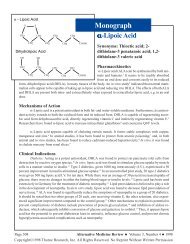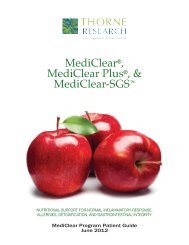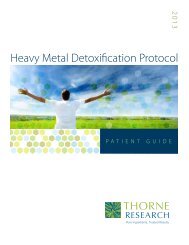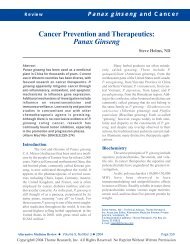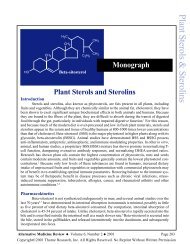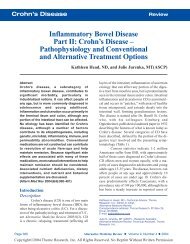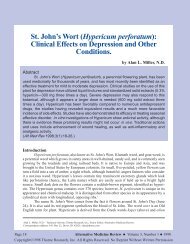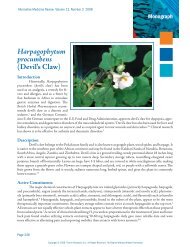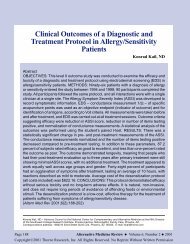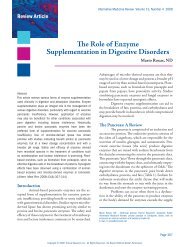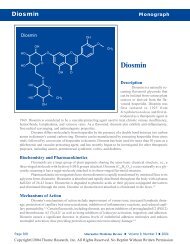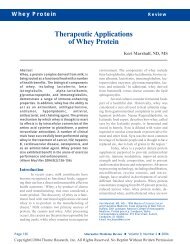Plantago ovata (Psyllium) - Thorne Research
Plantago ovata (Psyllium) - Thorne Research
Plantago ovata (Psyllium) - Thorne Research
You also want an ePaper? Increase the reach of your titles
YUMPU automatically turns print PDFs into web optimized ePapers that Google loves.
Monograph <strong>Plantago</strong> <strong>ovata</strong> (<strong>Psyllium</strong>)<br />
<strong>Plantago</strong> <strong>ovata</strong> (<strong>Psyllium</strong>)<br />
Description<br />
Although true psyllium comes from the plant <strong>Plantago</strong> psyllium,<br />
the husk and seed of <strong>Plantago</strong> <strong>ovata</strong> (Plantaginaceae) is commonly<br />
referred to as psyllium. <strong>Psyllium</strong> is widely used as a fiber<br />
supplement for the treatment of constipation. <strong>Psyllium</strong> husk is obtained<br />
by milling the seed of P. <strong>ovata</strong> to remove the hulls. In some<br />
studies the seed has been used instead of the husk, and is also commercially<br />
available.<br />
Active Constituents<br />
<strong>Psyllium</strong> husk contains a high proportion of hemicellulose,<br />
composed of a xylan backbone linked with arabinose, rhamnose, and<br />
galacturonic acid units (arabinoxylans). The seed consists of 35-percent<br />
soluble and 65-percent insoluble polysaccharides (cellulose,<br />
hemicellulose, and lignin). <strong>Psyllium</strong> is classified as a mucilaginous<br />
fiber due to its powerful ability to form a gel in water. This ability<br />
comes from its role as the endosperm of the P. <strong>ovata</strong> seed, where it<br />
functions to retain water in order to prevent the seed from drying out.<br />
Mechanisms of Action<br />
Many studies have shown dietary fiber shortens gastrointestinal transit time and increases stool<br />
weight. 1 When given to healthy volunteers, 18 grams daily of psyllium husk increased fecal weight and the<br />
production of short chain fatty acids. 2 Most of the psyllium was shown to reach the cecum four hours after<br />
ingestion in an intact and highly polymerized form. The husk appears to be relatively resistant to fermentation.<br />
<strong>Psyllium</strong> husks also significantly increase the level of stool moisture, as well as wet and dry stool<br />
weight. 3<br />
Anaerobic fermentation of the soluble non-starch polysaccharides from psyllium seed results in the<br />
production of the short-chain fatty acids acetate, propionate, and butyrate in the intestines. 4 <strong>Psyllium</strong> husk<br />
contains only the epidermis of the seed, while the actual seed has a higher amount of fermentable fiber.<br />
Because of this fiber content, psyllium seed degrades more slowly than pectin and produces fairly large<br />
amounts of butyrate and acetate. Butyric acid exhibits antineoplastic activity against colorectal cancer, is<br />
the preferred oxidative substrate for colonocytes, and may be helpful in the treatment of ulcerative colitis.<br />
In a study of resected colorectal cancer patients, those given 20 grams of psyllium seed daily for three<br />
months exhibited an average increase of butyric acid production of 42 percent, which decreased to pretreatment<br />
levels within two months of cessation of supplementation. 5<br />
<strong>Psyllium</strong> also has hypocholesterolemic effects, although the exact mechanism by which psyllium<br />
husk brings about a reduction of cholesterol is not totally clear. Animal studies have shown psyllium increases<br />
the activity of cholesterol 7 alpha-hydroxylase (the rate-limiting enzyme in bile acid synthesis also<br />
referred to as cytochrome 7A [CYP7A]) more than twice that of cellulose or oat bran, but less than<br />
Alternative Medicine Review ◆ Volume 7, Number 2 ◆ 2002 Page 155<br />
Copyright©2002 <strong>Thorne</strong> <strong>Research</strong>, Inc. All Rights Reserved. No Reprint Without Written Permission
<strong>Plantago</strong> <strong>ovata</strong> (<strong>Psyllium</strong>) Monograph<br />
cholestyramine. 6 In animals fed a high-fat diet,<br />
psyllium increased the activity of cholesterol 7<br />
alpha-hydroxylase and HMG-CoA reductase. 7<br />
This animal study also noted both pectin and psyllium<br />
reduced Apo B secretion and that LDL catabolic<br />
rates were 100-percent faster in animals fed<br />
psyllium. In a human study, psyllium lowered LDL<br />
cholesterol, decreased cholesterol absorption, and<br />
increased the fractional turnover of both chenodeoxycholic<br />
and cholic acids. 8 The authors’ conclusion<br />
was that psyllium lowered LDL cholesterol<br />
primarily via stimulation of bile acid synthesis.<br />
Further research might show this action to<br />
be through the stimulation of cholesterol 7 alphahydroxylase<br />
in humans as well.<br />
Clinical Indications<br />
Constipation<br />
The effectiveness of fiber, and psyllium<br />
in particular, on constipation depends on the main<br />
cause of the constipation. In a study of 149 patients<br />
with chronic constipation, the consumption<br />
of 15-30 grams daily of a psyllium seed preparation<br />
provided bowel relief in 85 percent of participants<br />
who had no known pathological cause<br />
for their constipation. Only 20 percent of individuals<br />
with slow transit responded to psyllium. A<br />
slightly greater percentage (37%) of those with<br />
disorders of defecation – including rectocele, internal<br />
prolapse, anismus, and rectal hyposensitivity<br />
– found improvement. 9<br />
Fecal Incontinence<br />
Because of its ability to retain water, psyllium<br />
has also been shown to benefit individuals<br />
with fecal incontinence from liquid stools or diarrhea.<br />
A placebo-controlled trial of persons with<br />
liquid stool fecal incontinence was performed in<br />
which supplementation with both gum arabic and<br />
psyllium showed approximately a 50-percent decrease<br />
in the occurrence of incontinent stools. The<br />
psyllium group had the highest water-holding capacity<br />
of water-insoluble solids and total waterholding<br />
capacity of the stool. 10<br />
Hemorrhoids<br />
With the known benefit of psyllium for<br />
both constipation and loose stools, it is not surprising<br />
it would also be of benefit for hemorrhoids.<br />
Fifty persons with internal bleeding hemorrhoids<br />
were given either a placebo of B vitamins or 11.6<br />
grams of Metamucil ® daily for 40 days. Individuals<br />
in the psyllium group had significant improvement<br />
in reduction of bleeding and a dramatic reduction<br />
of congested hemorrhoidal cushions.<br />
Bleeding on contact stopped after treatment in the<br />
psyllium group, while those in the control group<br />
experienced no difference. 11 It also appears psyllium<br />
treatment for this problem must be done for<br />
a minimum of one month, as a study of 30-day<br />
fiber supplementation failed to show improvement;<br />
12 whereas, when taken for 40 days significant<br />
improvement was noted. 13<br />
Ulcerative Colitis<br />
In an open label, randomized, multi-center<br />
trial of persons with ulcerative colitis, psyllium<br />
seed supplementation (10 grams twice daily)<br />
was as effective as mesalamine in maintaining<br />
remission. 14 This effect may likely be due to increased<br />
levels of butyric acid with psyllium<br />
supplementation.<br />
Appetite<br />
<strong>Psyllium</strong> may also have an effect on appetite.<br />
A triple-blind study on 17 women looked<br />
at the effect of taking 20 grams of psyllium seed<br />
three hours pre-meal and again immediately postmeal<br />
during three 3-day study periods. The subjects<br />
reported significantly increased feelings of<br />
fullness one hour after meals with the psyllium,<br />
and exhibited a significantly lower fat intake with<br />
those meals. 15<br />
Hyperlipidemia<br />
<strong>Psyllium</strong> has been shown to reduce total<br />
cholesterol and LDL cholesterol in animals 16-18 and<br />
in humans. Sprecher et al demonstrated a 3.5-percent<br />
reduction in total cholesterol and a 5.1-percent<br />
reduction in LDL levels after consuming 5.1<br />
grams of psyllium husk twice daily for eight<br />
weeks. 19 Another study began with individuals on<br />
Page 156 Alternative Medicine Review ◆ Volume 7, Number 2 ◆ 2002<br />
Copyright©2002 <strong>Thorne</strong> <strong>Research</strong>, Inc. All Rights Reserved. No Reprint Without Written Permission
Monograph <strong>Plantago</strong> <strong>ovata</strong> (<strong>Psyllium</strong>)<br />
the American Heart Association Step-1 diet, then<br />
added eight weeks of psyllium, resulting in decreased<br />
total cholesterol (4.8%) and LDL (8.8%). 20<br />
A meta analysis was performed on eight trials of<br />
psyllium husk in conjunction with a low-fat diet<br />
in the treatment of hypercholesterolemia. After an<br />
initial eight-week, low-fat diet run-in, 10.2 g psyllium<br />
were given per day, resulting in a four-percent<br />
reduction in serum total cholesterol and a<br />
seven-percent reduction in LDL cholesterol, compared<br />
to diet and placebo. A six-percent reduction<br />
in the ratio of apolipoprotein (apo) B to apo A-I<br />
was also noted. 21 Longer trials (16 weeks 22 and 26<br />
weeks 23 ) mirrored the above results.<br />
A meta-analysis of 12 studies of psylliumenhanced<br />
cereal product consumption on total and<br />
LDL cholesterol in 404 adults with mild to moderate<br />
hypercholesterolemia demonstrated a reduction<br />
of total cholesterol and LDL cholesterol of five- and<br />
nine-percent, respectively. 24 <strong>Research</strong>ers studied the<br />
effect of fiber-enhanced cookies on blood lipids in<br />
hypercholesterolemic men, using wheat bran-, psyllium-,<br />
or oat bran-containing cookies (wheat bran<br />
was used as the placebo since it has no demonstrated<br />
cholesterol-lowering effect). At the end of the eightweek<br />
study, plasma LDL cholesterol had decreased<br />
22.6-percent in the psyllium group and 26-percent<br />
in the oat bran group. 25<br />
A four-month study of 12 elderly patients<br />
showed psyllium husk reduced total serum cholesterol<br />
by 20 percent, a figure much higher than the<br />
above-mentioned studies. 26 In another study, a significant<br />
reduction in total serum cholesterol was noted<br />
in 176 elderly persons who used psyllium for one<br />
year. 27 The authors found for every one-gram increase<br />
in daily psyllium dose there was a 0.022-mmol/liter<br />
(0.84mg/dl) decrease in serum total cholesterol concentration.<br />
In the first study to examine age and gender<br />
differences in the effect of psyllium on blood lipids,<br />
men and pre- and postmenopausal women were given<br />
psyllium (15 grams daily) or placebo. <strong>Psyllium</strong> lowered<br />
plasma LDL cholesterol by 7-9 percent in all<br />
groups. Triglyceride levels were lowered by 17 percent<br />
in men, but were increased by 16 percent in<br />
postmenopausal women. Premenopausal women<br />
displayed no significant shift in triglycerides. 28<br />
Diabetes mellitus<br />
The effect of psyllium husk was studied<br />
in 34 men with type 2 diabetes and hypercholesterolemia<br />
given either placebo or 5.1 g psyllium<br />
twice daily for eight weeks. Total cholesterol was<br />
lower by 8.9 percent and LDL by one percent. In<br />
addition, the postprandial rise of glucose was significantly<br />
reduced. 29<br />
Drug-Botanical Interactions<br />
Changes in plasma drug levels have not<br />
been noted. One study in female rabbits showed<br />
that while guar gum reduced the absorption of<br />
ethinylestradiol, psyllium actually slightly increased<br />
the total absorption, but caused a slower<br />
absorption rate. 30<br />
Side Effects/Toxicity<br />
No adverse effects of supplementation<br />
with either psyllium seed or husk were noted in<br />
any clinical studies noted in this paper. In many<br />
of the studies there were greater levels of adverse<br />
effects with the placebo. No changes in blood indices<br />
or in vitamin or mineral content were found<br />
in any of those studies (including both meta-analyses).<br />
A 52-week study of 93 healthy individuals<br />
did find there were some small but statistically<br />
significant changes in some measurements of mineral<br />
and vitamin levels and in some hematological<br />
and biochemical parameters. But the authors<br />
note that none were of clinical significance with<br />
the possible exception of reduced levels of vitamin<br />
B12. 31<br />
Dosage<br />
Based on the above studies, the recommended<br />
dosage for psyllium husk ranges from 10-<br />
30 g daily, in divided doses. Starting with a lower<br />
dose and increasing gradually is often recommended.<br />
Keeping well hydrated while taking psyllium<br />
will prevent constipation.<br />
Warnings/Contraindications<br />
Several cases have been published of individual<br />
allergic and anaphylactic reactions to<br />
psyllium, 32-35 so caution must be exercised in this<br />
regard.<br />
Alternative Medicine Review ◆ Volume 7, Number 2 ◆ 2002 Page 157<br />
Copyright©2002 <strong>Thorne</strong> <strong>Research</strong>, Inc. All Rights Reserved. No Reprint Without Written Permission
<strong>Plantago</strong> <strong>ovata</strong> (<strong>Psyllium</strong>) Monograph<br />
References<br />
1. Devroede G. Constipation. In: Sleisinger MH,<br />
Fordtran JS, eds. Gastrointestinal Disease:<br />
Pathophysiology, Diagnosis, Management.<br />
Philadelphia, PA: WB Saunders; 1993:837-<br />
887.<br />
2. Marteau P, Flourie B, Cherbut C, et al.<br />
Digestibility and bulking effect of ispaghula<br />
husks in healthy humans. Gut 1994;35:1747-<br />
1752.<br />
3. Marlett JA, Kajs TM, Fischer MH. An<br />
unfermented gel component of psyllium seed<br />
husk promotes laxation as a lubricant in<br />
humans. Am J Clin Nutr 2000;72:784-789.<br />
4. Mortensen PB, Nordgaard-Andersen I. The<br />
dependence of the in vitro fermentation of<br />
dietary fibre to short-chain fatty acids on the<br />
contents of soluble non-starch polysaccharides.<br />
Scan J Gastroenterol 1993;28:418-422.<br />
5. Nordgaard I, Hove H, Clausen MR, Mortensen<br />
PB. Colonic production of butyrate in patients<br />
with previous colonic cancer during long-term<br />
treatment with dietary fibre (<strong>Plantago</strong> <strong>ovata</strong><br />
seeds). Scand J Gastroenterol 1996;31:1011-<br />
1020.<br />
6. Matheson HB, Colon IS, Story JA. Cholesterol<br />
7 alpha-hydroxylase activity is increased by<br />
dietary modification with psyllium hydrocolloid,<br />
pectin, cholesterol and cholestyramine in<br />
rats. J Nutr 1995;125:454-458.<br />
7. Vergara-Jimenez M, Conde K, Erickson SK,<br />
Fernandez ML. Hypolipidemic mechanisms of<br />
pectin and psyllium in guinea pigs fed high<br />
fat-sucrose diets: alterations on hepatic<br />
cholesterol metabolism. J Lipid Res<br />
1998;39:1455-1465.<br />
8. Everson GT, Daggy BP, McKinley C, Story<br />
JA. Effects of psyllium hydrophilic mucilloid<br />
on LDL-cholesterol and bile acid synthesis in<br />
hypercholesterolemic men. J Lipid Res<br />
1992;33:1183-1192.<br />
9. Voderholzer WA, Schatke W, Muhldorfer BE,<br />
et al. Clinical response to dietary fiber treatment<br />
of chronic constipation. Am J<br />
Gastroenterol 1997;92:95-98.<br />
10. Bliss DZ, Jung HJ, Savik K, et al. Supplementation<br />
with dietary fiber improves fecal<br />
incontinence. Nurs Res 2001;50:203-213.<br />
11. Perez-Miranda M, Gomez-Cedenilla A, Leon-<br />
Colombo T, et al. Effect of fiber supplements<br />
on internal bleeding hemorrhoids.<br />
Hepatogastroenterology 1996;43:1504-1507.<br />
12. Broader JH, Gunn IF, Alexander-Williams J.<br />
Evaluation of a bulk-forming evacuant in the<br />
management of hemorrhoids. Br J Surg<br />
1974;61:142-144.<br />
13. Webster DJ, Pugh DC, Craven JL. The use of<br />
bulk evacuant in patients with hemorrhoids. Br<br />
J Surg 1978;65:291-292.<br />
14. Fernandez-Banares F, Hinojosa J, Sanchez-<br />
Lombrana JL, et al. Randomized clinical trial<br />
of <strong>Plantago</strong> <strong>ovata</strong> seeds (dietary fiber) as<br />
compared with mesalamine in maintaining<br />
remission in ulcerative colitis. Am J<br />
Gastroenterol 1999;94:427-433.<br />
15. Turnbull WH, Thomas HG. The effect of<br />
<strong>Plantago</strong> <strong>ovata</strong> seed containing preparation on<br />
appetite variables, nutrient and energy intake.<br />
Int J Obes Relat Metab Disord 1995;19:338-<br />
342.<br />
16. Fernandez ML. Distinct mechanisms of<br />
plasma LDL lowering by dietary fiber in the<br />
guinea pig: specific effects of pectin, guar<br />
gum, and psyllium. J Lipid Res 1995;36:2394-<br />
2404.<br />
17. Fernandez ML, Ruiz LR, Conde AK, et al.<br />
<strong>Psyllium</strong> reduces plasma LDL in guinea pigs<br />
by altering hepatic cholesterol homeostasis. J<br />
Lipid Res 1995;36:1128-1138.<br />
18. Terpstra AH, Lapre JA, de Vries HT, Beynen<br />
AC. Hypocholesterolemic effect of dietary<br />
psyllium in female rats. Ann Nutr Metab<br />
2000;44:223-228.<br />
19. Sprecher DL, Harris BV, Goldberg AC, et al.<br />
Efficacy of psyllium in reducing serum<br />
cholesterol levels in hypercholesterolemic<br />
patients on high- or low-fat diets. Ann Intern<br />
Med 1993;119:545-554.<br />
20. Bell LP, Hectorne K, Reynolds H,<br />
Hunninghake DB. Cholesterol-lowering effects<br />
of psyllium hydrophilic mucilloid. JAMA<br />
1989;261:3419-3423.<br />
21. Anderson JW, Allgood LD, Lawrence A, et al.<br />
Cholesterol-lowering effects of psyllium intake<br />
adjunctive to diet therapy in men and women<br />
with hypercholesterolemia: meta-analysis of 8<br />
controlled trials. Am J Clin Nutr 2000;71:472-<br />
479.<br />
22. Levin EG, Miller VT, Muesing RA, et al.<br />
Comparison of psyllium hydrophilic mucilloid<br />
and cellulose as adjuncts to a prudent diet in<br />
the treatment of mild to moderate hypercholesterolemia.<br />
Arch Intern Med 1990;150:1822-<br />
1827.<br />
Page 158 Alternative Medicine Review ◆ Volume 7, Number 2 ◆ 2002<br />
Copyright©2002 <strong>Thorne</strong> <strong>Research</strong>, Inc. All Rights Reserved. No Reprint Without Written Permission
Monograph <strong>Plantago</strong> <strong>ovata</strong> (<strong>Psyllium</strong>)<br />
23. Anderson JW, Davidson MH, Blone L, et al.<br />
Long-term cholesterol-lowering effects of<br />
psyllium as an adjunct to diet therapy in the<br />
treatment of hypercholesterolemia. Am J Clin<br />
Nutr 2000;71:1433-1438.<br />
24. Olson BH, Anderson SM, Becker MP, et al.<br />
<strong>Psyllium</strong>-enriched cereals lower blood total<br />
cholesterol and LDL cholesterol, but not HDL<br />
cholesterol, in hypercholesterolemic adults:<br />
results of a meta-analysis. J Nutr<br />
1997;127:1973-1980.<br />
25. Romero AL, Romero JE, Galviz S, Fernandez<br />
ML. Cookies enriched with psyllium or oat<br />
bran lower plasma LDL cholesterol in normal<br />
and hypercholesterolemic men from Northern<br />
Mexico. J Am Coll Nutr 1998;17:601-608.<br />
26. Burton R, Manninen V. Influence of a psyllium-based<br />
fibre preparation on faecal and<br />
serum parameters. Acta Med Scand<br />
1982;668:S91-S94.<br />
27. Stewart RB, Hale WE, Moore MT, et al. Effect<br />
of psyllium hydrophilic mucilloid on serum<br />
cholesterol in the elderly. Dig Dis Sci<br />
1991;36:329-334.<br />
28. Vega-Lopez S, Vidal-Quintanar RL, Fernandez<br />
ML. Sex and hormonal status influence plasma<br />
lipid responses to psyllium. Am J Clin Nutr<br />
2001;74:435-441.<br />
29. Anderson JW, Allgood LD, Turner J, et al.<br />
Effects of psyllium on glucose and serum lipid<br />
responses in men with type 2 diabetes and<br />
hypercholesterolemia. Am J Clin Nutr<br />
1999;70:466-473.<br />
30. Garcia JJ, Fernandez N, Diez MJ, et al.<br />
Influence of two dietary fibers in the oral<br />
bioavailability and other pharmacokinetic<br />
parameters of ethinyloestradiol. Contraception<br />
2000;6:253-257.<br />
31. Oliver SD. The long-term safety and tolerability<br />
of ispaghula husk. J R Soc Health<br />
2000;120:107-111.<br />
32. Lantner RR, Espiritu BR, Zumerchik P, Tobin<br />
MC. Anaphylaxis following ingestion of a<br />
psyllium-containing cereal. JAMA<br />
1990;264:2534-2536.<br />
33. James JM, Cooke SK, Barnett A, Sampson<br />
HA. Anaphylactic reactions to a psylliumcontaining<br />
cereal. J Allergy Clin Immunol<br />
1991;88:402-408.<br />
34. Suhonen R, Kantola I, Bjorksten F. Anaphylactic<br />
shock due to ingestion of psyllium laxative.<br />
Allergy 1983;38:363-365.<br />
35. Freeman GL. <strong>Psyllium</strong> hypersensitivity. Ann<br />
Allergy 1994;73:490-492.<br />
Alternative Medicine Review ◆ Volume 7, Number 2 ◆ 2002 Page 159<br />
Copyright©2002 <strong>Thorne</strong> <strong>Research</strong>, Inc. All Rights Reserved. No Reprint Without Written Permission



